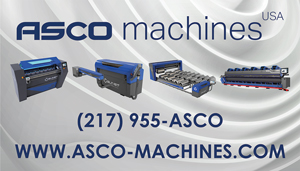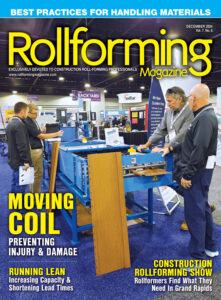By Ben Schmidt, Industry Sales Manager – Metal Buildings, Trim & Decking, The Bradbury Group
Changing the way you do business will always require some research, plenty of planning and some sort of investment. Purchasing your first in-house roll forming line is certainly no exception.

A respectable roll former manufacturer will guide you through the process, first of all, making sure the investment makes sense and that you’re ready. Manufacturing your own panels can be a great way to gain control over your business and ensure the quality of products you’re offering
How Much Will You Produce?
The roll formers we’re talking about usually produce 29-gauge or 26-gauge exposed fastener panels, to be used as residential roofing or perhaps, as barn kits or post-frame buildings. You’ll be stocking coil measuring 40.875 inches wide to produce these panel profiles.
Everyone wants a quick return on their investment. Investing a few hundred thousand dollars on a roll former means it has to be cranking out a lot of panels to make the purchase worthwhile. Roofers like to talk in squares; roll former operators talk in footage or how many truckloads of coil they go through in a month’s time. Running a million feet a year, typically, justifies your roll former purchase.
Consider Other Equipment
No matter what the panels are used for, they won’t be of much use to anyone without trim pieces. Because the margin on trim is much greater than on panels, it’s recommended that anyone purchasing a roll former should already have a trim shop in place.
A trim shop and a roll forming line require a lot of space. If a client is putting up a new building, the ideal building size is 150 feet by 300 feet. That should be plenty large enough for the trim shop, the roll forming line, your coil stock and an office. For those looking at moving into an existing building, keep in mind the roll forming line will require a space of approximately 90 feet long by 10 feet wide to operate safely.

Your line will include a decoiler, your actual roll forming stations and a finished product handling area. At some point, it may include a packaging station as well. Customers can be advised on choosing a single mandrel or double mandrel uncoiler. The double mandrel uncoiler will require more space but helps reduce the time it takes to change coils.
Will your roll forming operation produce one profile, or does your market indicate a second profile may be profitable? If you’re producing one profile, a single high roll former should meet your needs. If your market will support a second profile, you’ll have to decide between a double high roll former or a rafting roll former, which allows you to interchange tooling for each profile. That tooling will be changed by a crane or forklift.

Is Training Included?
Operating a roll former requires training, provided by the manufacturer, including learning how to adjust guides and dies to ensure a quality end product. Operators must be able to recognize a variety of consistency issues from one end of the line to the other.
Consistent overlap, length accuracy and panel coverage are the most important items required for the main operator to maintain.
A big investment requires plenty of research. Roll forming manufacturers can answer your questions and help you get what you need to change the way you do business by taking control of production.
About The Bradbury Company
The companies of the Bradbury Group are known for the cutting-edge technology and reliability built into every product — and for the exceptional service that helps satisfy customers worldwide. Bradbury strives to set the standard for automated production and systems integration in the metal processing industry. Bradbury believes its leveling, cutoff, punch, folding and roll forming machines and automated systems set the highest standard for productivity, reliability and safety in coil processing. RF



















